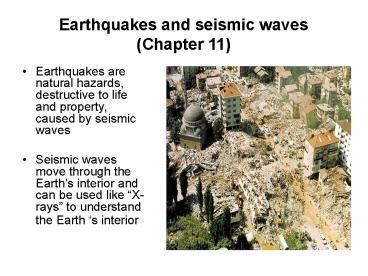Earthquakes and seismic waves (Chapter 11) - PowerPoint PPT Presentation
Title:
Earthquakes and seismic waves (Chapter 11)
Description:
... Liquifaction of clay rich sediments Liquifaction of clay rich sediments Lands Earthquake hazards: Tsunamis seismic sea waves Preparing for ... – PowerPoint PPT presentation
Number of Views:511
Avg rating:3.0/5.0
Title: Earthquakes and seismic waves (Chapter 11)
1
Earthquakes and seismic waves(Chapter 11)
- Earthquakes are natural hazards, destructive to
life and property, caused by seismic waves - Seismic waves move through the Earths interior
and can be used like X-rays to understand the
Earth s interior
2
How do earthquakes occur?
- Stresses build up in the crust, usually due to
lithospheric plate motions - Rock deform (strain) as the result of stress.
The strain is energy stored in the rocks.
3
How do earthquakes occur?
- When the rocks reach their elastic limit, they
break, and energy is released in the form of
seismic waves, radiating out from the earthquake
focus - The rocks return to their original shape, with a
displacement (slip) along the fault
4
Earthquake focus center of rupture or slip,
seismic waves radiate out from the
focusEarthquake epicenter the point on the
Earths surface over the focus
5
Kind of seismic waves
- P-waves most rapid (8 km/sec)
- S-waves slower (5 km/sec), cannot move through
liquids - Surface waves even slower, move only on
surface, most destructive
6
Surface waves
7
Detecting and measuring seismic waves
- Seismometers
- The paper roll moves with the ground
- The pen remains stationary, because of the
spring, hinge and weight
8
Seismogram
- Tells you
- How far away the earthquake occurred, based on
the time difference between p and s wave
arrivals - Magnitude of ground motion, based on the
amplitude of the surface waves
9
The time interval between p and s-wave arrivals
tells you how far away the epicenter is
10
Triangulate from 3 stations to locate the
epicenter
11
Earthquake magnitude is related to the amount of
energy released by the earthquake. The Richter
magnitude ML is measured using the amplitude of
the seismic waves. Another measure is called the
moment magnitude Mw
12
(No Transcript)
13
Some Notable Earthquakes
Indonesia (12/04)
China (5/08) Pakistan (10/05)
14
Earthquake hazards
- Ground vibration and motion
- Liquifaction of clay rich sediments
- Landslides
- Tsunami
15
- Earthquake hazards
- Liquifaction of clay rich sediments
16
Earthquake hazards
- Liquifaction of clay rich sediments
- Landslides
17
Earthquake hazards Tsunamis seismic sea waves
- very long wavelength, deep wavebase
- speeds up to 800 km/hour, 15- 30 meters high
18
Tsunami Northern Sumatra December 2004
19
(No Transcript)
20
http//www.tsunami.noaa.gov/
Many tsunamis originate at circum-Pacific
convergent margins, therefore the Pacific Tsunami
Warning system was established
21
Preparing for earthquakes
- Assess hazards (how will an earthquake affect an
area) - Assess likelihood (probability, based on location
of faults and prior events) - Modify zoning regulations and building codes to
withstand hazard
22
- Forecasting Earthquakes
- Unlike, volcanic eruptions, short-term warnings
(precursors) are not well known - Real-time warning (after earthquake has occurred)
can be effective radio waves fiber optic
transmissions to shut down reactors, close gas
lines, etc. within seconds or minutes - Long term earthquake probability is estimated
using the Seismic Gap Method
23
http//www.iris.edu/seismon































